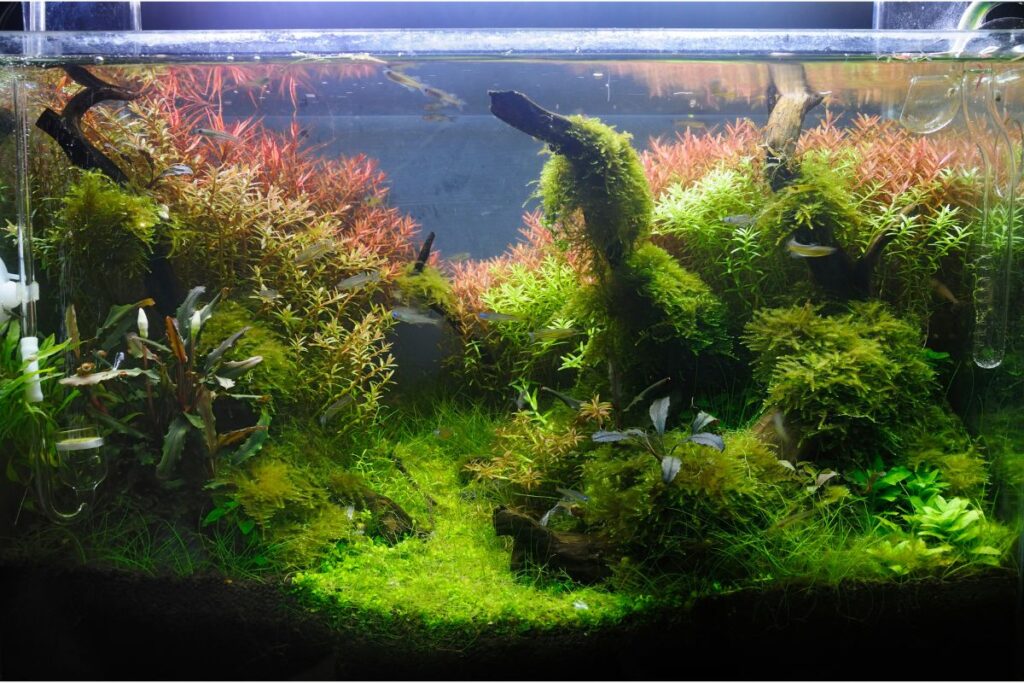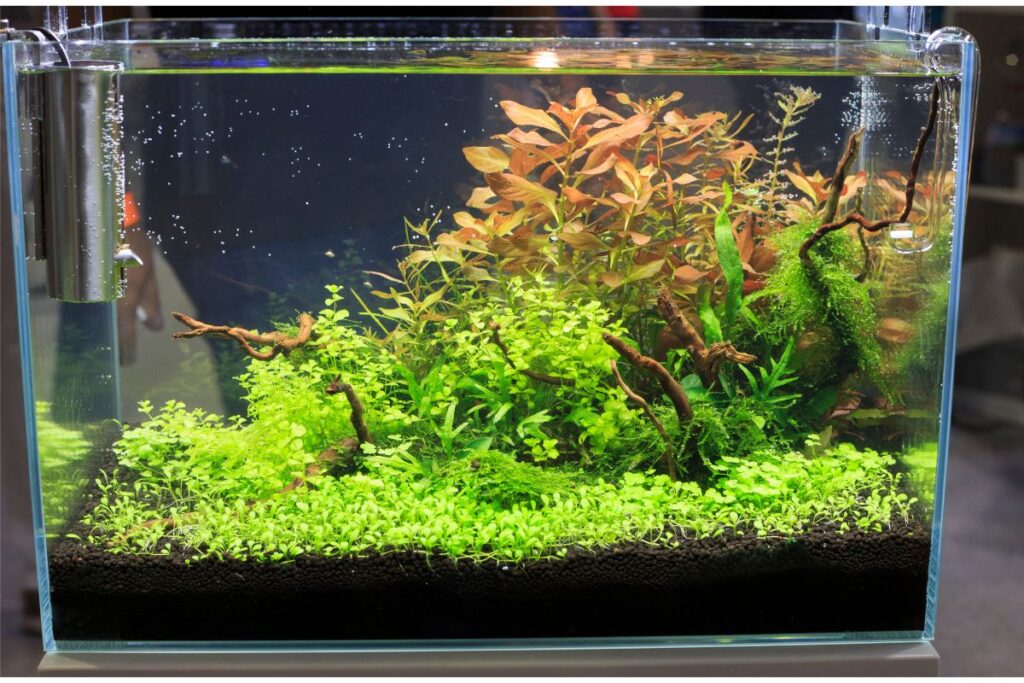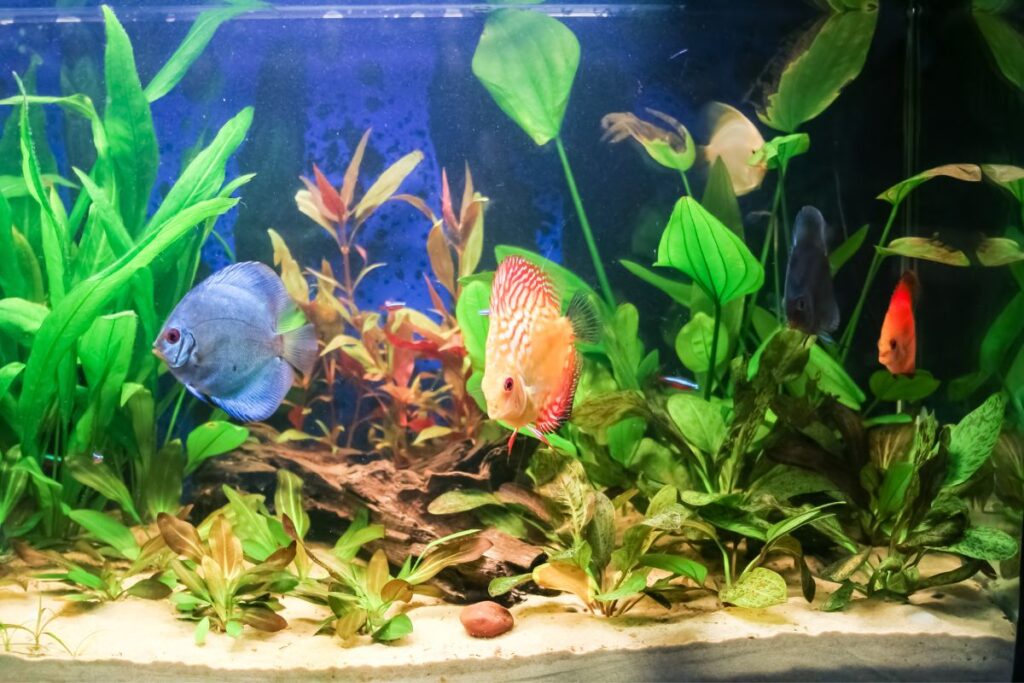Do you have aquarium plants? If so, you may be wondering if they need soil. The answer is yes! Soil can help your aquarium plants to grow healthier and stronger. But there are also some cons to consider before using soil in your tank. In this article, we’ll discuss the pros and cons of using soil for aquarium plants, as well as alternative substrates like gravel and sand. We’ll also take a look at what to look for when choosing the right substrate for your tank. With all this information, you’ll be able to make an informed decision about whether or not soil is the right choice for your aquarium plants.

Contents
Pros of Soil for Aquarium Plants
You’ll love the benefits that come with using soil for your aquatic plants! Soil provides the ideal environment for healthy root nutrition, helping your plants absorb the necessary nutrients and minerals they need to thrive. The soil also acts as a buffer for water changes, keeping the pH levels balanced so you can keep your aquatic friends living in optimal conditions. Additionally, it helps light penetrate deeper into the aquarium substrate, giving your plants access to more photosynthetic energy.
Not only does soil help with nutrient absorption and light penetration, but it is also an excellent medium for fertilizer absorption which will provide extra nutrition to your aquascape. The addition of soil to an aquarium also helps regulate temperature by providing insulation from sudden temperature fluctuations. This means that any extreme shifts in temperature won’t affect the health of your underwater garden or its inhabitants.
Adding soil into an aquarium offers many useful advantages that will not only benefit plant life but all other aquatic lifeforms as well. From providing balanced pH levels to regulating temperatures, using soil for your aquarium can be incredibly beneficial when done properly and thoughtfully!
Cons of Soil for Aquarium Plants
Not having soil can be a con for aquatic vegetation, as roots need something to anchor in and absorb nutrients from. Aquarium soil may not provide optimal nutrition for aquatic plants since it is not a natural substrate found in their natural environment. This can cause deficiencies in essential minerals that help support root health and CO2 levels, which are vital for plant growth. Additionally, aquarium soil can release excess nutrients into the water that could get trapped by filtration systems, leading to poor water quality conditions and algae blooms.
When compared to other substrates such as gravel or sand, aquarium soil is much more prone to compaction which limits oxygenation of the roots and the ability of plants to uptake necessary nutrients from the water column. Compacted layers of the substrate can also lead to anaerobic conditions where unwanted bacteria and fungi will thrive. This bacterial activity releases toxins that can harm fish or lead to changes in pH balance that could otherwise be avoided with other substrates.
Aquarium soil is also known to contain organic matter like peat moss which lowers pH levels over time, making it difficult for many species of fish or invertebrates with specific habitat requirements. Furthermore, when adding new elements like fertilizers or root tabs directly into aquarium soil, there is no guarantee they won’t affect fish or become trapped by filtration systems causing ammonia spikes over time. Taking all these factors into consideration when setting up your tank might save you some headaches down the road!
Aquarium Soil Alternatives
Gravel

Gravel is a great alternative to aquarium soil if you’re looking for something to support your aquatic plants without the hassle. Gravel provides plenty of surface area for beneficial bacteria to colonize, and doesn’t require any special lighting requirements or fertilizing needs. It also helps stabilize water chemistry and can provide an anchor point for rooted plants when combined with proper planting techniques. There are many types of gravel substrates available in different sizes, shapes, and colors that can be used in aquariums.
When selecting a gravel substrate for your aquarium, make sure it is free from any contaminants such as dirt, sand, or clay particles. You should also choose one that matches the color scheme of your tank so that it doesn’t detract from its overall aesthetic appeal. Furthermore, you should avoid using sharp-edged gravels since they may damage delicate plant roots over time. If possible, rinse the substrate before adding it to the tank to remove any dust or debris that could cloud up the water quality.
Gravel is an excellent choice for aquascaping because it allows you to create unique designs with minimal effort. You can use larger pieces of gravel as focal points around which smaller pieces are arranged – this creates depth and texture within the aquascape while providing plenty of nutrient-rich surface area for beneficial microorganisms to grow on. Additionally, using multiple colors of gravel gives your planted tank a vibrant look that stands out against other tanks with plain backgrounds!
Sand

Sand can be a great alternative to traditional aquarium soil, offering an attractive substrate with plenty of surface area for beneficial bacteria and other microorganisms to colonize. When it comes to aquascaping, sand is often used in combination with other substrate types like gravel or rocks. This helps create a natural look and makes it easy to replicate the environment of many popular fish species. Additionally, sand has the added benefit of improving water quality by trapping organic matter and detritus. It also provides excellent lighting requirements as light reflects off its light-colored surface more efficiently than darker substrates.
When using sand as an aquarium soil alternative, it’s important to use fertilizer sparingly as too much can cause plant growth problems. The best way to add nutrients is through root tabs that are placed just below the surface of the substrate so that plants have access but won’t absorb too much nitrogen or phosphorus all at once. If you’re looking for a low-maintenance option that still looks aesthetically pleasing, then sand could be the perfect choice for your tank!
Sand has plenty of practical benefits and will help bring your aquarium vision to life with its stunning visuals. With proper care and maintenance, this material can offer long-lasting results while helping keep your fish healthy and safe from toxins or contaminants in their habitat.
What To Look For When Choosing Aquarium Soil
When selecting a substrate for your tank, it’s important to consider the type of environment you want to create and the requirements of the fish or invertebrates that will be living in it. The substrate should be able to provide adequate nutrition, lighting requirements, soil composition, water balance and nutrient needs. It is also important to make sure that the aquarium plants are compatible with the selected substrate as some soils may not provide enough nutrients for certain types of plants.
The best way to ensure that your aquarium soil meets all of these criteria is to purchase one specifically designed for use in aquariums. These substrates come in many varieties such as gravel, sand, clay pellets and other specialized materials. They are often treated with additives such as fertilizer or trace elements which enhance their ability to support healthy plant growth and promote beneficial bacteria colonies within the tank’s ecosystem.
It is always wise to research any substrate before buying it so that you know exactly what it contains and how it will affect your tank’s environment. Additionally, when selecting an aquarium soil consider whether it has been tested for safety and if any additional treatments may be necessary in order for it to function optimally within your particular setup. By taking these steps you can ensure that your tank remains healthy and thriving over time!
Conclusion
You’ve now seen the pros and cons of aquarium soil for plants as well as alternatives like gravel and sand. Ultimately, it’s up to you to decide which option is best for your aquarium. Consider factors like cost, availability, ease of use, and whether or not the substrate will provide the necessary nutrients for your plants. With some research and experimentation, you can find an aquarium soil solution that works perfectly for you! Don’t forget to keep an eye on how your plants are doing – regular maintenance and water changes will help ensure they stay healthy and vibrant over time.
